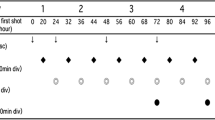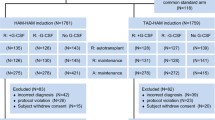Abstract
One hundred twelve patients with geriatric acute myeloid leukemia (AML), refractory or relapsed AML, or myelodysplastic syndrome and refractory anemia with excess of blasts in transformation (MDS-RAEBt) were entered into this study to receive CAG (aclarubicin and low-dose cytosine arabinoside [Ara-C]in combination with granulocyte colony-stimulating factor [G-CSF]) with the objective of evaluating the efficacy and tolerance of this regimen. Low-dose Ara-C was given subcutaneously at a dosage of 10 mg/m2 every 12 hours on days 1 to 14. Aclarubicin was administered intravenously at a dosage of 14 mg/m2 per day on days 1 to 4 (CAG regimen A) or 7 mg/m2 on days 1 to 8 (CAG regimen B). Recombinant G-CSF was given subcutaneously at a dosage of 200 µg/m2 per day on days 1 to 14. We demonstrated comparable overall complete remission rates for the 4 groups of patients: 30.8% (8/26) in the elderly patients, 48.4% (30/62) in the refractory AML patients, 44.4% (8/18) in the relapsed AML patients, and 38.5% (5/13) in the MDS-RAEBt patients. Of the 52 patients followed up, the 12-month progression-free survival (PFS) and overall survival (OS) rates estimated by the Kaplan-Meier method were 40.73% ± 8.15% and 42.85% ± 8.23%, respectively. The median PFS and OS times were 9.0 ± 2.2 months and 11.0 ± 1.6 months, respectively. Toxic effects were very rare and mainly consisted of neutropenia and thrombocytopenia due to myelo-suppression; approximately 70% to 80% of patients had neutropenia or thrombocytopenia that exceeded National Cancer Institute grade II. Nonhematologic toxicities were not observed in this study. The CAG regimen seems promising, with acceptable toxicity, for the treatment of various categories of poor-prognosis AML and MDS-RAEBt.
Similar content being viewed by others
References
Oosterveld M, Muus P, Suciu S, et al. for the EORTC, EBMT, SAKK, GIMEMA Leukemia Groups and the MD Anderson Cancer Center. Chemotherapy only compared to chemotherapy followed by transplantation in high risk myelodysplastic syndrome and secondary acute myeloid leukemia: two parallel studies adjusted for various prognostic factors.Leukemia. 2002;16:1615–16211.
Cripe LD, Hinton S. Acute myeloid leukemia in adults.Curr Treat Options Oncol. 2000;1:9–17.
Miller KB. Myelodysplastic syndromes.Curr Treat Options Oncol. 2000;1:63–69.
Pagano L, Pulsoni A, Tosti ME, et al. and the Italian GIMEMA Group (Gruppo Italiano Malattie Ematologiche dell’Adulto). Acute leukemia following a previous malignancy: do acute lymphoid leukemia and acute myeloid leukemia have common risk factors?Hematol J. 2000;1:329–332.
Beaumont M, Sanz M, Carli PM, et al. Therapy-related acute promyelocytic leukemia.J Clin Oncol. 2003;21:2123–2137.
Panizo C, Patino A, Lecumberri R, et al. Secondary myelodysplastic syndrome after treatment for promyelocytic leukemia: clinical and genetic features of two cases.Cancer Genet Cytogenet. 2003; 143:178–181.
Byrd JC, Mrozek K, Dodge RK, et al. Pretreatment cytogenetic abnormalities are predictive of induction success, cumulative incidence of relapse, and overall survival in adult patients with de novo acute myeloid leukemia: results from Cancer and Leukemia Group B (CALGB 8461).Blood. 2002;100:4325–4336.
Tsimberidou AM, Stavroyianni N, Viniou N, et al. for the Hellenic Cooperative Group. Comparison of allogeneic stem cell transplantation, high-dose cytarabine, and autologous peripheral stem cell transplantation as postremission treatment in patients with de novo acute myelogenous leukemia.Cancer. 2003;97:1721–1731.
Martino R, Caballero MD, Simon JA, et al. for the AML and alloPBSCT subcommittees of the Spanish Group for Hematopoietic Transplantation. Evidence for a graft-versus-leukemia effect after allogeneic peripheral blood stem cell transplantation with reduced-intensity conditioning in acute myelogenous leukemia and myelodysplastic syndromes.Blood. 2002;100:2243–2245.
Gurman G, Arat M, Ilhan O, et al. Allogeneic hematopoietic cell transplantation without myeloablative conditioning for patients with advanced hematologic malignancies.Cytotherapy. 2001;3:253–2600.
Molina A, Popplewell L, Kashyap A, Nademanee A. Hematopoietic stem cell transplantation in the new millennium: report from City of Hope National Medical Center.Clin Transpl. 2000:317–3422.
Giles FJ, Kantarjian HM, Cortes JE, et al. Adaptive randomized study of idarubicin and cytarabine versus troxacitabine and cytarabine versus troxacitabine and idarubicin in untreated patients 50 years or older with adverse karyotype acute myeloid leukemia.J Clin Oncol. 2003;21:1722–1727.
Pastore D, Specchia G, Carluccio P, et al. FLAG-IDA in the treatment of refractory/relapsed acute myeloid leukemia: single-center experience.Ann Hematol. 2003;82:231–235.
Anderson JE, Kopecky KJ, Willman CL, et al. Outcome after induction chemotherapy for older patients with acute myeloid leukemia is not improved with mitoxantrone and etoposide compared to cytarabine and daunorubicin: a Southwest Oncology Group study.Blood. 2002;100:3869–3876.
Schaich M, Illmer T, Aulitzky W, et al. and the SHG AML96 Study Group. Intensified double induction therapy with high dose mitoxantrone, etoposide, m-amsacrine and high dose Ara-C for elderly acute myeloid leukemia patients aged 61–65 years.Haematologica. 2002;87:808–815.
Larson RA, Boogaerts M, Estey E, et al. Antibody-targeted chemotherapy of older patients with acute myeloid leukemia in first relapse using Mylotarg (gemtuzumab ozogamicin).Leukemia. 2002;16:1627–1636.
Kini J, Khadilkar UN, Dayal JP. A study of the haematologic spectrum of myelodysplastic syndrome.Indian J Pathol Microbiol. 2001;44:9–12.
Bai A, Kojima H, Hori M, et al. Priming with G-CSF effectively enhances low-dose Ara-C-induced in vivo apoptosis in myeloid leukemia cells.Exp Hematol. 1999;27:259–265.
Saito K, Nakamura Y, Aoyagi M, et al. Low-dose cytarabine and aclarubicin in combination with granulocyte colony-stimulating factor (CAG regimen) for previously treated patients with relapsed or primary resistant acute myelogenous leukemia (AML) and previously untreated elderly patients with AML, secondary AML, and refractory anemia with excess blasts in transformation.Int J Hematol. 2000;71:238–244.
Saito K, Furusawa S, Yamada K, et al. Comparison of low-dose cytosine arabinoside and aclarubicin in combination with granulocyte colony-stimulating factor to intermediate-dose cytosine arabinoside and mitoxantrone with or without etoposide in the treatment of relapsed acute myeloid leukemia [in Japanese].Rinsho Ketsueki. 1995;36:165–174.
Author information
Authors and Affiliations
Corresponding author
About this article
Cite this article
Li, J.M., Shen, Y., Wu, D.P. et al. Aclarubicin and Low-Dose Cytosine Arabinoside in Combination with Granulocyte Colony-Stimulating Factor in Treating Acute Myeloid Leukemia Patients with Relapsed or Refractory Disease and Myelodysplastic Syndrome: A Multicenter Study of 112 Chinese Patients. Int J Hematol 82, 48–54 (2005). https://doi.org/10.1532/IJH97.A10424
Received:
Revised:
Accepted:
Published:
Issue Date:
DOI: https://doi.org/10.1532/IJH97.A10424




